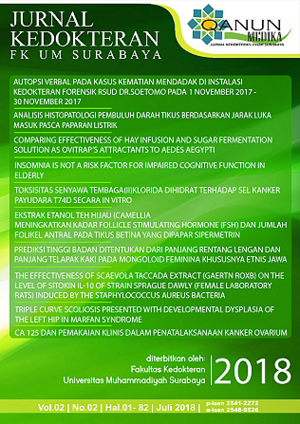Toksisitas Senyawa Tembaga(II)Klorida Dihidrat Terhadap Sel Kanker Payudara T74D Secara in vitro
Abstract
Cancer is a transformation of normal cells in the body into malignancy due to the induction of carcinogens. Breast cancer is the second leading cause of death in Indonesia. The field of treatment with inorganic compounds has been widely developed and shows better anticancer activity than organic compounds. This research aims to know the toxicity level of copper value of 29.021 μg/ml. The value of IC 50 obtained <100 μg/ml so that the copper
Cancer is a transformation of normal cells in the body into malignancy due to the induction ofcarcinogens. Breast cancer is the second leading cause of death in Indonesia. The field oftreatment with inorganic compounds has been widely developed and shows better anticanceractivity than organic compounds. This research aims to know the toxicity level ofcoppervalue of 29.021 μg/ml. The value of IC50obtained<100 μg/ml so that the copperFull text article
References
Afrasiabi Z, Sinn E, Padhye S, Dutta S, Padhye S, Newton C, Anson CE, Powell AK, (2003), Transition Metal Complexes o Phenanthrenequinone Thiosemicarbazone as Potential Anticancer Agents: Synthesis, Structure, Spectroscopy, Electrochemistry and In vitro Anticancer Activity Against Human Breast Cancer Cell-line, T47D, Journal of Inorganic Biochemistry, Vol. 95, Hal. 306-314
Ali I, Waseem AW, Kishwr S, Ming-Fa S, (2013), Design and Synthesis of Thaliomide Based Dithiocarbamate Cu(II), Ni(II) and Ru(III) Complexes as Anticancer Agents, Polyhedron, Vol. 56, Hal. 134-143.
Anonimus, (2017), Data dan Informasi Profil Kesehatan Indonesia 2016, (Diunduh pada: 21 Februari 2018 pada: http://www.depkes.go.id/resources/download/pusdatin/lain-lain/Data%20dan%20Informasi%20Kesehatan%20Profil%20Kesehatan%20Indonesia%202016%20-%20%20smaller%20size%20-%20web.pdf)
Chauhan M, Farukh A, (2006), Chiral and Achiral Macrocyclic Copper( II ) Complexes: Synthesis, Characterization, and Comparative Binding Studies with Calf-Thymus DNA, Chemistry and Biodiversity, Vol. 3, Hal. 660-676.
Devereux M, McCann M, Shea DO, Kelly R, Egan D, Deegan C, Kavanagh K, McKee V, Finn G, (2004), Synthesis, Antimicrobial Activity and Chemotherapeutic Potential of Inorganic Derivatives of 2-(4’-thiazolyl)benzimidazole{thiabendazole}: X-ray Crystal Structure of [Cu(TBZH)2Cl]Cl.H2O.EtOH and TBZH2NO3 (TBZH = thiabendazole), Journal of Inorganic Biochemistry, Vol. 98, Hal. 1023-1031
Devereux M, Shea DO, Kellett A, McCann M, Walsh M, Egan D, Deegan C, Kedziora K, Rosair G, Muller-Bunz H, (2007), Synthesis, X-ray Crystal Structures and Biomimetic and Anticancer Activities of Novel Copper(II)benzoate complexes incorporating 2-(4′-thiazolyl)benzimidazole (thiabenzole), 2-(2-pyridyl)benzimidazole and 1,10-phenanthroline as Chelating Nitrogen Donor Ligands, Journal of Inorganic Biochemistry, Vol. 101, Hal. 881-892
Dhahagani K, Kumar SM, Chakkaravarthi G, Anitha K, Rajesh J, Ramu A, Rajagopal G, (2014), Synthesis and spectral characterization of Schiff base complexes of Cu(II), Co(II), Zn(II) and VO(IV) containing 4-(4-aminophenyl) morpholine derivatives: Antimicrobial evaluation and anticancer studies, Elsevier, Spectrochimica Acta Part A: Molecular and Biomolecular Spectroscopy, Vol. 117, Hal. 87–94
Franks LM, Teich NM. (1998), Introduction to the Cellular and Molecular Biology of Cancer, Oxford University Press, New York
Galal SA, Hegab KH, Kassab AS, Rodrigues ML, Kerwin SM, El-Khamry AA, El Diwani HI, (2009), New Transition Metal Ion Complexes with Benzimidazole-5-carboxylic Acid Hydrazides with Antitumor Activity, European Journal of Medicinal Chemistry, Vol. 44, Hal. 1500-1508
Guadarrama OS, Horacio LP, Francisco SB, Isabel GM,
Herbert H, Norah BB, (2009), Cytotoxic Activity, X-Ray Crystal Structures and Spectroscopic Characterization of Cobalt(II), Copper(II) and Zinc(II) Coordination Compounds with 2-ubstituted Benzimidazole, Journal of Inorganic Biochemistry, Vol. 103, Hal. 1204-1213
Huheey JE, Ellen AK, Richard LK, (1993), Inorganic Chemistry:Principle of Structure and Reactivity, Harper Collins College, United States of America
Lee JR. (2008), Kanker Payudara Pencegahan dan Pengobatannya, Daras Books, Jakarta
Linder MC, Maryam HA, (1996), Copper Biochemistry and Molecular Biology, American Journal of clinical Nutrition, Vol. 63, Hal. 797-811
Merchant B, (1998), Gold, the noble metal and the paradoxes of its toxicology, Biologicals, Vol. 26, Hal. 49-59
Meyer BN, Ferrighi NR, Putnam JE, Jacobsen LB, Nichols DE, Mclaughlin JL, (1982), Brine Shrimp: A Convenient General Bioassay for active Plant Constituents, Planta Medica, Vol. 45, Hal. 31-34.
Mosmann T, (1983), Rapid Colorimetric Assay for Cellular Growth and Survival: Application to Proliferation and Cytotoxicity Assays, Journal of Immunolgical Methods, Vo. 65, Hal. 55-63
Panyala NR, Peña-Méndez E, Havel J, (2009), Gold and nano-gold in medicine: Overview, toxicology and perspectives, Journal of applied biomedicine, Vol. 7, Hal. 75-91
Sperandio S, Belle I, Bredesen DE, 2000, An alternative, nanopoptotic form of programmed cell death, PNAS, Vol. 97, Hal. 14376-14381
Sucipto TH, Churrotin S, Setyawati H, Kotaki T, Martak F, Soegijanto S, (2017), Antiviral Activity of Copper(II)Chloride Dihydrate Against Dengue Virus Type-2 in Vero Cell, Indonesian Journal of Tropical and Infectious Disease, Vol. 6, Hal. 84-87
Sucipto TH, Churrotin S, Setyawati H, Mulyatno KC, Amarullah IH, Ueda S, Kotaki T, Sumarsih S, Wardhani P, Bendryman SS, Aryati, Soegijanto S, Kameoka M, (2017), Inhibitory Activity of Cobalt(II)-Morin Complex Against The Replication of Dengue Virus Type 2, Indonesian Journal of Tropical and Infectious Disease, Vol. 6, Hal. 141-144
Tardito S, Marchio L, (2009), Copper compounds in anticancer strategies, Current Medicinal Chemistry, Vol. 16, Hal. 1325-1348
Authors

Qanun Medika by FK UM Surabaya is liscence under Lisensi Creative Commons Atribusi 4.0 Internasional.

